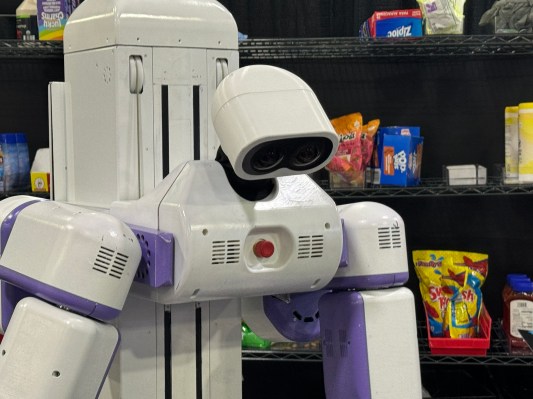Agility’s Digit wasn’t the only humanoid holding court at Modex in Atlanta this week. On the opposite end of the Georgia World Congress Center, Reflex Robotics, a younger and smaller startup, was drawing its own crowd. The booth was centered on a single demo running throughout the week. Passersby requested something from the Reflex robot, and it spring into action, grabbing the item off the shelf (it didn’t hurt that the company was giving out free food and beverage).
From the look of it, most showgoers were impressed by the system’s speed and accuracy. The hardware is an in-house design, featuring a “torso” mounted to a base that allows the arms and sensors to dynamically move up and down. It makes for a surprisingly dexterous robot that can access shelves at a variety of heights, while maneuvering tight spaces. The system has a wheeled base, which is perfectly effective for navigating these kinds of layouts.

Image Credits: Brian Heater
Something that needs be mentioned is the fact that the system is primarily tele-operated. It’s an example of a human in the loop system, whereby it can be controlled remotely. The only real constraints there are potential latency issues if the operator is moved too far. Co-founder and CEO Ritesh Ragavender compares the interface to a video game. He adds that the robot is “approaching” human-level efficiency.
The team is moving toward a system that requires fewer and fewer people. As the robot grows more autonomous and capable, the human element will shift from control to supervisor. Humans stick around as a kind of fail-safe, should the robot get into trouble or encounter something entirely new. For now, however, the human-to-robot ratio is 1:1. Ragavender says he believes the company will achieve a 1:2 ratio in warehouses and 3PLs (third-party logistics) by early next year.

Image Credits: Brian Heater
The robot putting in the hours at Modex is a second-generation system, which is currently being selectively piloted with potential customers, including some “big names,” per Ragavender. He adds that the current timeline involves having 10 to 20 Reflex robots in the world, followed by “hundreds” next year.
“I think the fact that you have a system that’s getting smarter the more it works, coupled with remote operators and a really low-cost robot is what allows us to scale this and make it work,” says Ragavender. “We’re ready to ship today.” The system’s current price point is “below $50,000.” Scaling manufacturing should be able to bring that number down further.

Image Credits: Reflex Robotics
The New York–based startup is still extremely lean, with just five people. The founders all come from MIT, in addition to companies like Boston Dynamics and Tesla. Reflex has thus far raised a seed round, led by Khosla Ventures. Ragavender says the startup will likely pursue a Series A later this year.
